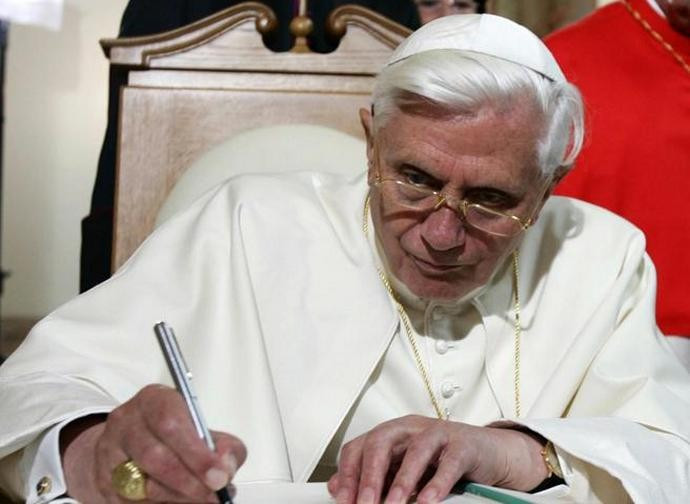The unpublished letter from Benedict XVI: 'My resignation is complete and valid'
The letter, written by the Pope Emeritus in August 2014 in response to objections regarding the validity and appropriateness of his resignation, is published for the first time in a book by Monsignor Nicola Bux (Realtà e utopia nella Chiesa [Reality and Utopia in the Church]), to whom it was addressed. This exceptional historical document should put an end to much sterile speculation.

"To say that in my resignation I would have left 'only the exercise of the ministry and not also the munus' is contrary to clear dogmatic-canonical doctrine. If some journalists speak of a 'creeping schism', they do not deserve any attention."
This is how Pope Emeritus Benedict XVI responded in a letter dated 21 August 2014 to Monsignor Nicola Bux, former counsellor member of the Congregation for the Doctrine of the Faith when cardinal Ratzinger was the Prefect, who had asked him about the doubts and perplexities that had accompanied his resignation from the papacy the previous year.
 This exceptional document, which should put an end to the long-running controversy over Benedict XVI's intentions regarding his resignation, is being published in full for the first time as an appendix to Nicola Bux's book Realtà e Utopia nella Chiesa (Reality and Utopia in the Church), written with Vito Palmiotti for the Libri della Bussola series.
This exceptional document, which should put an end to the long-running controversy over Benedict XVI's intentions regarding his resignation, is being published in full for the first time as an appendix to Nicola Bux's book Realtà e Utopia nella Chiesa (Reality and Utopia in the Church), written with Vito Palmiotti for the Libri della Bussola series.
In response to the objections presented to him, Benedict XVI considers the resignation of a Pope to be 'fully' valid, and the parallelism 'between the diocesan bishop and the Bishop of Rome with regard to the question of resignation' to be 'well-founded'. He also defends the right of a pope to speak and write outside of his official duties, as he himself did by continuing to write books during his pontificate, such as the volumes dedicated to Jesus, which he considered 'a mission from the Lord'.
This letter, the existence of which was known but which had never been published by Monsignor Bux in order to prevent it from becoming yet another tool for fierce and pointless controversy, is of fundamental historical importance. It allows us to understand the Pope Emeritus's intentions regarding his resignation and the establishment of the emeritus pontificate, as well as his broader theological vision of the papacy. It also closes the debate on who has been the ‘true Pope’ in recent years — a controversy that has always seemed unrealistic to rational people, but which has unfortunately attracted many to ‘false prophets’.
The book includes a photocopy of the letter, alongside the text of the letter sent by Monsignor Nicola Bux. This letter contains several objections to the resignation, as well as the related risk of 'desacralisation' of the papacy. It concludes with some critical assessments of the Pope Emeritus's responses.
 Benedict XVI is also one of the book's protagonists, and the correspondence with Monsignor Nicola Bux forms an appendix to it. The book provides an original analysis of the crisis of faith sweeping through the Church, comparing the healthy realism of John Paul II and Pope Ratzinger ('The principle of reality made person' is the title of the chapter dedicated to Pope Ratzinger) with the utopianism of Pope Francis and his 'precursor': Monsignor Tonino Bello, who continues to exert considerable influence within the Italian Church, a fact acknowledged by Pope Bergoglio himself.
Benedict XVI is also one of the book's protagonists, and the correspondence with Monsignor Nicola Bux forms an appendix to it. The book provides an original analysis of the crisis of faith sweeping through the Church, comparing the healthy realism of John Paul II and Pope Ratzinger ('The principle of reality made person' is the title of the chapter dedicated to Pope Ratzinger) with the utopianism of Pope Francis and his 'precursor': Monsignor Tonino Bello, who continues to exert considerable influence within the Italian Church, a fact acknowledged by Pope Bergoglio himself.
Utopia has indeed afflicted the Church since the post-conciliar period, regaining vigour with the pontificate of Pope Francis after John Paul II and Benedict XVI centred their teaching and pastoral action on the words of the Apostle: 'Reality, however, is Christ'. The authors attribute the evident doctrinal deviations in the post-synodal exhortation Amoris Laetitia and the encyclical Fratelli Tutti to utopianism, as in these documents Christ is no longer the foundation of either marriage or human brotherhood.
This is therefore a useful, short study for understanding recent events in the Church and current dynamics. In short, it is a must-read book published in Italian by La Bussola.
To purchase the book click here.




